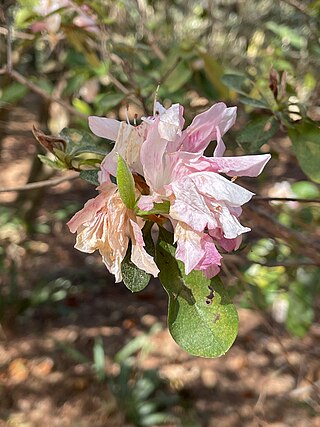
In physics, the kinetic energy of an object is the form of energy that it possesses due to its motion.

In Newtonian mechanics, momentum is the product of the mass and velocity of an object. It is a vector quantity, possessing a magnitude and a direction. If m is an object's mass and v is its velocity, then the object's momentum p is:
In physics, power is the amount of energy transferred or converted per unit time. In the International System of Units, the unit of power is the watt, equal to one joule per second. In older works, power is sometimes called activity. Power is a scalar quantity.

The Schrödinger equation is a linear partial differential equation that governs the wave function of a quantum-mechanical system. Its discovery was a significant landmark in the development of quantum mechanics. It is named after Erwin Schrödinger, who postulated the equation in 1925 and published it in 1926, forming the basis for the work that resulted in his Nobel Prize in Physics in 1933.

Septoria are ascomycete pycnidia-producing fungi that cause numerous leaf spot diseases on field crops, forages and many vegetables including tomatoes which are known to contract Septoria musiva from nearby cottonwood trees, and is responsible for yield losses. The genus is widespread, and estimated to contain 1072 species. Pycnidia produce needle-like pycnidiospores.

In thermodynamics, the Gibbs free energy is a thermodynamic potential that can be used to calculate the maximum amount of work, other than pressure-volume work, that may be performed by a thermodynamically closed system at constant temperature and pressure. It also provides a necessary condition for processes such as chemical reactions that may occur under these conditions. The Gibbs free energy is expressed as
Time dilation is the difference in elapsed time as measured by two clocks, either due to a relative velocity between them, or a difference in gravitational potential between their locations. When unspecified, "time dilation" usually refers to the effect due to velocity.
In linear algebra, it is often important to know which vectors have their directions unchanged by a linear transformation. An eigenvector or characteristic vector is such a vector. Thus an eigenvector of a linear transformation is scaled by a constant factor when the linear transformation is applied to it: . The corresponding eigenvalue, characteristic value, or characteristic root is the multiplying factor .

A capacitor is an electronic device that stores electrical energy in an electric field by accumulating electric charges on two closely spaced surfaces that are insulated from each other. It is a passive electronic component with two terminals.
Septoria azaleae is a fungal plant pathogen infecting azaleas.
Monilinia azaleae is a species of fungus in family Sclerotiniaceae. A plant pathogen, it was first formally described by Edwin Earle Honey in 1936.

Ovulinia azaleae is a plant pathogen affecting azaleas and rhododendrons.
Ovulitis azaleae is a plant pathogen affecting azaleas and rhododendrons.

Graphocephala fennahi is a species of leafhopper native to the United States. Its common name derives from it feeding on the sap of rhododendrons. The species was introduced to Great Britain in the 1930s and continental Europe in the 1970s. There has been suggestion that the rhododendron leafhopper contributes to the spread of a rhododendron fungus through Europe.
Teichosporella is a genus of fungi in the class Dothideomycetes. The relationship of this taxon to other taxa within the class is unknown. The genus was first described by Italian mycologist Pier Andrea Saccardo in 1895.
Edwin Earle Honey was an American plant pathologist and mycologist. In 1936, he formally described the fungus and plant pathogen Monilinia azaleae, which preys upon crops and other plants in the families Rosaceae and Ericaceae.

Cynthia Westcott was an American plant pathologist, author, and expert on roses. She published a number of books and handbooks on horticulture and plant disease. Westcott was nicknamed "The Plant Doctor", and is credited with starting the "first ornamental disease diagnosis business" in the United States. Her work was featured in The New York Times, House and Garden, and The American Home. She identified the cause of the plant disease Ovulinia azaleae and a novel treatment for it.

Asphondylia is a cosmopolitan genus of gall midges in the family Cecidomyiidae. All species in this genus induce galls on plants, especially on flowers and flower buds. There are over 300 described species in Asphondylia, with many more likely to be discovered and described, especially in the southern hemisphere.
Heterothrips is a genus of thrips in the family Heterothripidae. There are more than 60 described species in Heterothrips.
Cephalotrichum is a genus of fungi belonging to the family Microascaceae.










